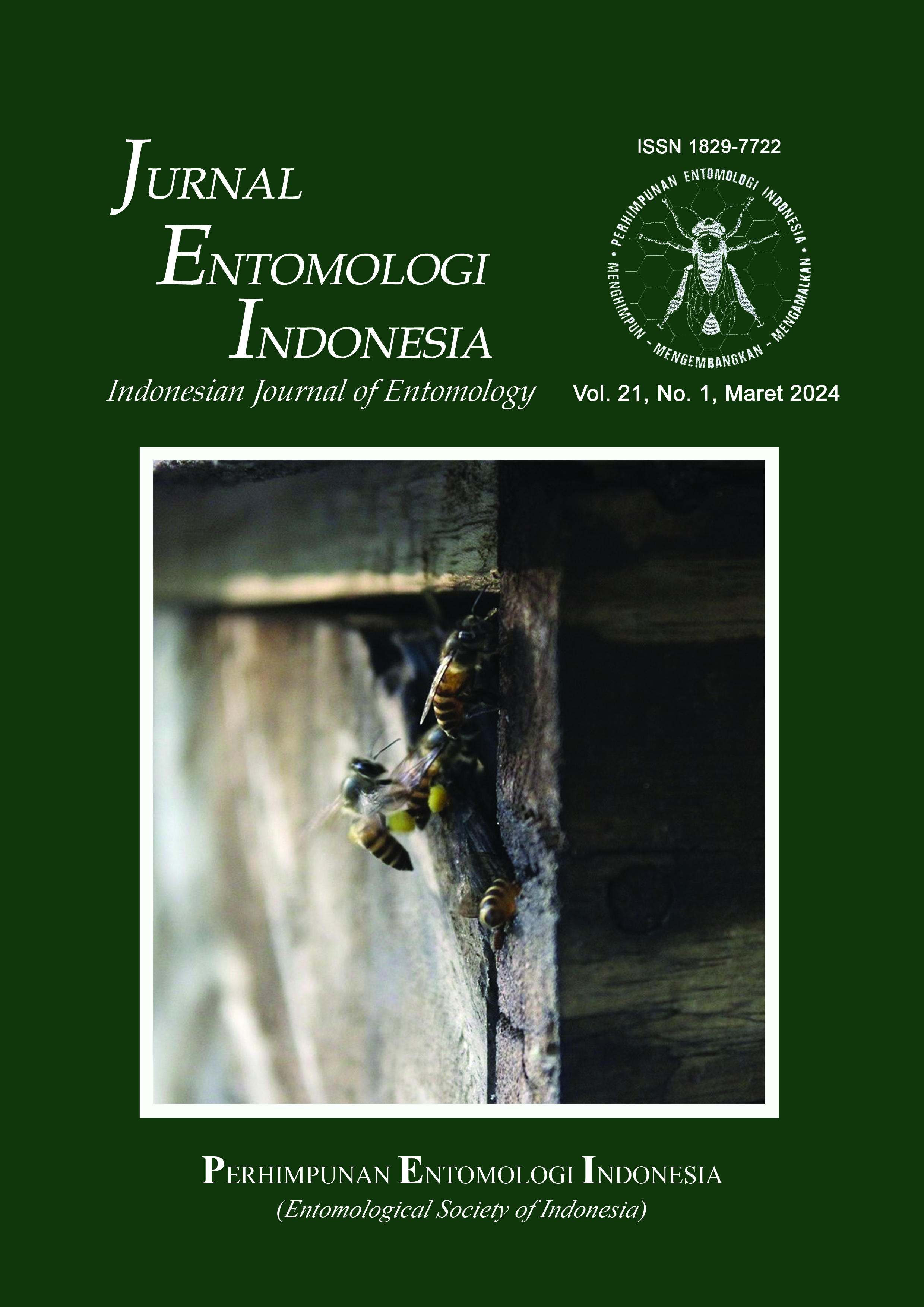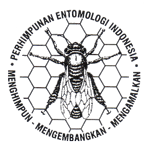New association between Cecidochares connexa (M.) (Diptera: Tephritidae) and local parasitoids: Revisiting classical biological control
Asosiasi baru antara Cecidochares connexa (M) (Diptera: Tephritidae) dan parasitoid lokal: Sebuah tinjauan terhadap pengendalian hayati klasik
DOI:
https://doi.org/10.5994/jei.21.1.63Keywords:
gall insects, invasive species, new association, parasitoidAbstract
The gall fly Cecidochares connexa (L.) (Diptera: Tephritidae) was introduced in Bantimurung, Polewali Mandar Regency, South Sulawesi in 1999, to control the Siam weed Chromolaena odorata, an invasive weed from Florida, United States. However, some previous studies have shown that C. connexa can be attacked by local predators and parasitoids, which can affect the effectiveness of C. connexa in the field. The objective of the research is to study the new interaction and association between the introduced C. connexa, and local parasitoids. The research was conducted in April-December 2021 at two habitats namely open fields and cocoa plantations, in four villages of Polewali Mandar Regency. Purposive sampling was conducted to collect C. odorata infested by the gall flies. Thirty C. odorata samples were collected from three different sites at each habitat and each village. The galls were grouped into two different categories i.e. those with and with out holes. The galls with holes were then reared until the insects emerged and the insect specimens were identified. The research results showed that the gall numbers, healthy and parasitized C. connexa at opened areas were significantly higher as compared to cocoa plantations. Parasitism phenomenon indicated the new interaction and association between the C. connexa with the local parasitoids. The parasitization rate of C. connexa in the opened fields (23.24%) was not significantly with in the cocoa plantations (28.84%). On the parasitized C. connexa were found four families of parasitoids i.e. Eulophidae, Braconidae, Eupelmidae, and Ormyridae. The dominant parasitoid found was Quadrastichus sp.1, with the parasitization rate of 14% in open fields and 10% in cocoa plantations.
Downloads
References
Abdala-Roberts L, Puentes A, Finke DL, Marquis RJ, Montserrat M, Poelman EH, Rasmann S, Sentis A, van Dam NM, Wimp G, Mooney K. 2019. Tri‐trophic interactions: bridging species, communities and ecosystems. Ecology Letters. 22:2151–2167. DOI: https://doi.org/10.1111/ele.13392.
Aigbedion-Atalor PO, Idemudia I, Witt ABR, Day MD. 2018. First record of the impact of the parasitism of Cecidochares connexa (Diptera: Tephritidae) by a solitary larval ectoparasitoid in West Africa: Cause for concern?. Journal Plant Disies Protection. 126:93–95. DOI: https://doi.org/10.1007/s41348-018-0189-x.
Aisyah MDN. 2019. Deskripsi Serangga yang Berasosiasi Puru Tumbuhan di Bogor dan Sekitarnya. Dissertation. Bogor: IPB University.
Anisa RP, Hidayat P, Buchori D, Pratyadhiraksana G, Abad JIM, de S Tavares W, Tarigan M. 2023. Parasitoids associated to Ophelimus eucalypti (gahan) (Hymenoptera: Eulophidae) on Eucalyptus (Myrtaceae) plantations in North Sumatra, Indonesia. IOP Confference Series: Earth Environment. 1133:012040. DOI: https://doi.org/10.1088/1755-1315/1133/1/012040.
Aterrado ED, Bachiller NSJ. 2002. Biological control of Chromolaena odorata: Preliminery studies on the use of the gall-forming fly Cecidochares connexa in the Phillipines. In: C. Zachariades, Muniappan R, Sthratie LW (Ed.), Proceedings of the 5th Internasional Workshop on Biological Control and Management of Chromolaena odorata (South Africa, 23–25 October 2000). pp. 137–139. South Africa: ARC- Plant Protection Research Institute.
Bhumannavar BS, Ramani S. 2006. Introduction of Cecidochares connexa (Macquart) (Diptera: Tephritidae) into India for the biological control of Chromolaena odorata. In: Lai PY, Reddy GVP, Muniappan R (eds.), Proceedings of the Seventh International Workshop on Biological Control and Management of Chromolaena odorata and Mikania micrantha (Pingtung, 12–15 September 2006). pp. 38–48. Pingtung: National Pingtung University Of Science And Technology.
Boughton AJ, Kula RR, Gates M, Zhang Y, Nunez M, Connor J O, Whitfield JB, Center TD. 2012. Parasitoids attacking larvae of a recently introduced weed biological control agent, Neomusotima conspurcatalis (Lepidoptera: Crambidae): Key to species, natural history and integrative taxonomy. Annals of The Entomological Society of America. 105:753–767. DOI: https://doi.org/10.1603/AN11157.
Buchori D, Rizali A, Lukvitasari L, Triwidodo H. 2020. Insect communities associated with siam weed: Evaluation after three decades of Cecidochares connexa release as biocontrol agent. Diversity. 12:344. DOI: https://doi.org/10.3390/d12090344.
Caltagirone LE. 1981. Landmark examples in classical biological control. Annual Review of Entomology. 26:213–232. DOI: https://doi.org/10.1146/annurev.en.26.010181.001241.
Caltagirone LE, Doutt RL. 1989. The history of the vedalia beetle importation to California and its impact on the development of biological control. Annual Review of Entomology. 34: 1–16. DOI: https://doi.org/10.1146/annurev.en.34.010189.000245.
Clausen CP (editor). 1978. Introduced Parasites and Predators of Arthropod Pests and Weeds: A World Review. USDA Agric. Handbook. 480:545
Day MD, Bofeng I, Nabo I. 2013. Successful biological control of Chromolaena odorata (Asteraceae) by the gall fly Cecidochares connexa (Diptera: Tephritidae) in Papua New Guinea. In : Wu Y, Johnson T, Sing S, Raghu S, Wheeler G, Pratt P, Warner K, Center T, Goolsby J, Reardon R (Ed.), Proceedings of the XIII International symposium on Biological Control of weeds (USA, 11–16 September 2011). pp. 400–408. USA: University of Georgia – Center for Invasive Species and Ecosystem Health.
DeBach P. 1964. Biological Control of Insect Pests and Weeds. New York: Reihold.
Goulet H, Huber JT. 1993. Hymenoptera of The World: An Identification Guides to Families. Ottawa: Centre for Land and Biological Resources Research.
Harjaka T, Mangoendihardjo S. 2010. Evaluasi lanjut penyebaran lalat argentina sebagai pengendali gulma siam. Jurnal Perlindungan Tanaman Indonesia. 16:42–46.
Hokkanen HM, Pimentel D. 1989. New associations in biological control: Theory and practice. The Canadian Entomologist. 121:829–840. DOI: https://doi.org/10.4039/Ent121829-10.
Indarwatmi M. 2006. Biologi dan Kisaran Inang Lalat Puru Cecidochares connexa (Macquart) (Diptera: Tephritidae) sebagai Agens Hayati Gulma Kirinyuh. Thesis. Bogor: IPB University.
Jaya SAH. 2006. Implikasi Eksistensi Chromolaena odorata (L.) King & Robinson (Asteraceae) dan Agens Hayatinya Cecidochares connexa Macquart (Diptera: Tephritidae) terhadap Struktur Komunitas Serangga dan Tumbuhan Lokal. Thesis. Bogor: Bogor Agricultural University
Kenis M, Hurley BP, Colombari F, Lawson S, Sun J, Wilken C. 2019. Guide to The Classical Biological Control of Insect Pests in Planted and Natural Forests. Rome: FAO.
Kim I, Mendel Z, Protasov A, Blumerg D, Salle john La. 2008. Taxonomy, biology, and efficacy of two Australian parasitoids of the eucalyptus. Zootaxa. 1910:1–20. DOI: https://doi.org/10.11646/zootaxa.1910.1.1.
Lukvitasari L, Triwidodo H, Rizali A, Buchori D. 2021. Pengaruh lokasi terhadap serangan lalat puru Cecidochares connexa (Macquart) pada tumbuhan eksotik invasif Chromolaena odorata (L.) King & Robinson dan interaksinya dengan komunitas serangga lokal. Jurnal Entomologi Indonesia 18:127–139. DOI: https://doi.org/10.5994/jei.18.2.127.
Maqsalina MN. 2021. Deskripsi dan Kunci Identifikasi Parasitoid Nyamuk Ganjur Alang-alang Orseolia javanica Kieffer & Van Leeuwen-Reijnvaan (Diptera: Cecidomyiidae) di Kabupaten Bogor dan Cianjur. Thesis. Bogor: IPB University.
McAlpine J F, Peterson BV, Shewell GE, Teskey HJ, Vockeroth JR, Wood DM. 1981. Manual of Nearctic Diptera. Canada: Canadian Government Publishing Centre.
McFadyen REC, De Chenon RD, Sipayung A. 2003. Biology and host specificity of the Chromolaena stem gall fly, Cecidochares connexa (Macquart) (Diptera: Tephritidae). Australian Journal of Entomolgy. 42:294–297. DOI: https://doi.org/10.1046/j.1440-6055.2003.00360.x.
Naumann ID, Carne PB, Lawrance JF, Nielsen ES, Spradbery JP, Taylor RW, Whitten MJ, Littlejohn MJ. 1991. The Insects of Australia. Austalia: CSIRO.
Ortega YK, Pearson DE, McKelvey KS. 2004. Effects of biological control agents and exotic plant invasion on deer mouse populations. Ecological Applications. 14:241–253. DOI: https://doi.org/10.1890/02-5276.
Padmanaba M, Tomlinson KW, Hughes AC, Corlett RT. 2017. Alien plant invasions of protected areas in Java, Indonesia. Scientific Report. 7: 9334. DOI: https://doi.org/10.1038/s41598-017-09768-z.
Pahlevi R. 2006. Identifikasi dan Pengamatan Status Parasitoid pada Cecidochares connexa (Diptera: Tephritidae). Skripsi. Bogor: IPB University.
Pearson DE, McKelvey KS, Ruggiero LF. 2000. Non-target effects of an introduced biological control agent on deer mouse ecology. Oecologia. 22:121–128. DOI: https://doi.org/10.1007/PL00008828.
Pearson DE,Callaway R.M. 2005. Indirect nontarget effects of host-specific biological control agents: Implications for biological control. Biological Control. 35:288–298. DOI: https://doi.org/10.1016/j.biocontrol.2005.05.011.
Reddy GV, Kikuchi R S, Muniappan R. 2010. The impact of Cecidochares connexa on Chromolaena odorata in Guam. In : Zachariades C, Strathie LW, Day MD, Muniappan R (Eds.), Proceedings of the Eighth International Workshop on Biological Control and Management of Chromolaena odorata and other Eupatorieae (Kenya, 1-2 November 2010). pp. 128–133. Kenya: ARC- Plant Protection Research Institute.
Safi’i I. 2006. Parasitisasi Pada Cecidochares connexa di Beberapa Tempat di Jawa Barat. Skripsi. Bogor: IPB University.
Schwarzlander M, Hinz HL, Winston RL, Day MD. 2018. Biological control of weeds: An analysis of introductions, rates of establishment and estimates of success, worldwide. BioControl. 63:319–331. DOI: https://doi.org/10.1007/s10526-018-9890-8.
Setyawati T, Narulita S, Bahri IP, Raharjo GT. 2015. A Guide Book to Invasive Alien Plant Species in Internasional. Bogor: Research, Development and Innovation Agency. Ministry of Environment and Forestry.
Tjitrosemito S. 1999. The establishment of Procecidochares Connexa in West Internasional, Internasional: A biological control agent of Chromolaena Odorata. Biotropia. 12:19–24.
Tjitrosemito S. 2002. Introduction and establishement of the gall fly Cecidochares connexa for control of Siam weed, Chromolaena odorata, in Java, Indonesia. In: Zachariades C, Muniappan R, Sthratie LW (Eds.), Proceedings of the 5th Internasional Workshop on Biological Control and Management of Chromolaena odorata (South Africa, 23-25 October 2000). pp. 140– 147. South Africa: ARC-Plant Protection Research Institute.
Tjitrosoedirdjo SS. 2005. Inventory of the invasive alien plant species in Indonesia. Biotropia. 25:60–73.
Wilson CG, Widayanto EB. 2004. Establishment and Spread of Cecidochares connexa in Eastern Internasional. In: Day MD, McFadyen RE (Ed.), Chromolaena in The Asia-Pacific Region. Proceedings of The 6th Internasional Workshop on Biological Control and Management of Chromolaena Held in Cairns (Australia, May 6–9, 2003). pp. 39–44. Australia: Australian Centre for Internasional Agricultural Research.
Winston RL, Schwarzlander M, Hinz HL, Day MD, Cock MJ, Julien MH. 2014. Biological control of weeds: A world catalogue of agents and their target weeds. Morgantown: USDA Forest Service, Forest Health Technology Enterprise Team.
Published
How to Cite
Issue
Section
License
Copyright (c) 2024 Muhammad Harianto, Hermanu Triwidodo, Nurariaty Agus, Damayanti Buchori

This work is licensed under a Creative Commons Attribution 4.0 International License.
Authors who publish with this journal agree to the following terms:
- Authors retain copyright and grant the journal right of first publication with the work simultaneously licensed under a Creative Commons Attribution 4.0 International License that allows others to share the work with an acknowledgement of the work's authorship and initial publication in this journal.
- Authors are able to enter into separate, additional contractual arrangements for the non-exclusive distribution of the journal's published version of the work (e.g., post it to an institutional repository or publish it in a book), with an acknowledgement of its initial publication in this journal.
- Authors are permitted and encouraged to post their work online (e.g., in institutional repositories or on their website) prior to and during the submission process, as it can lead to productive exchanges, as well as earlier and greater citation of published work (See The Effect of Open Access).








